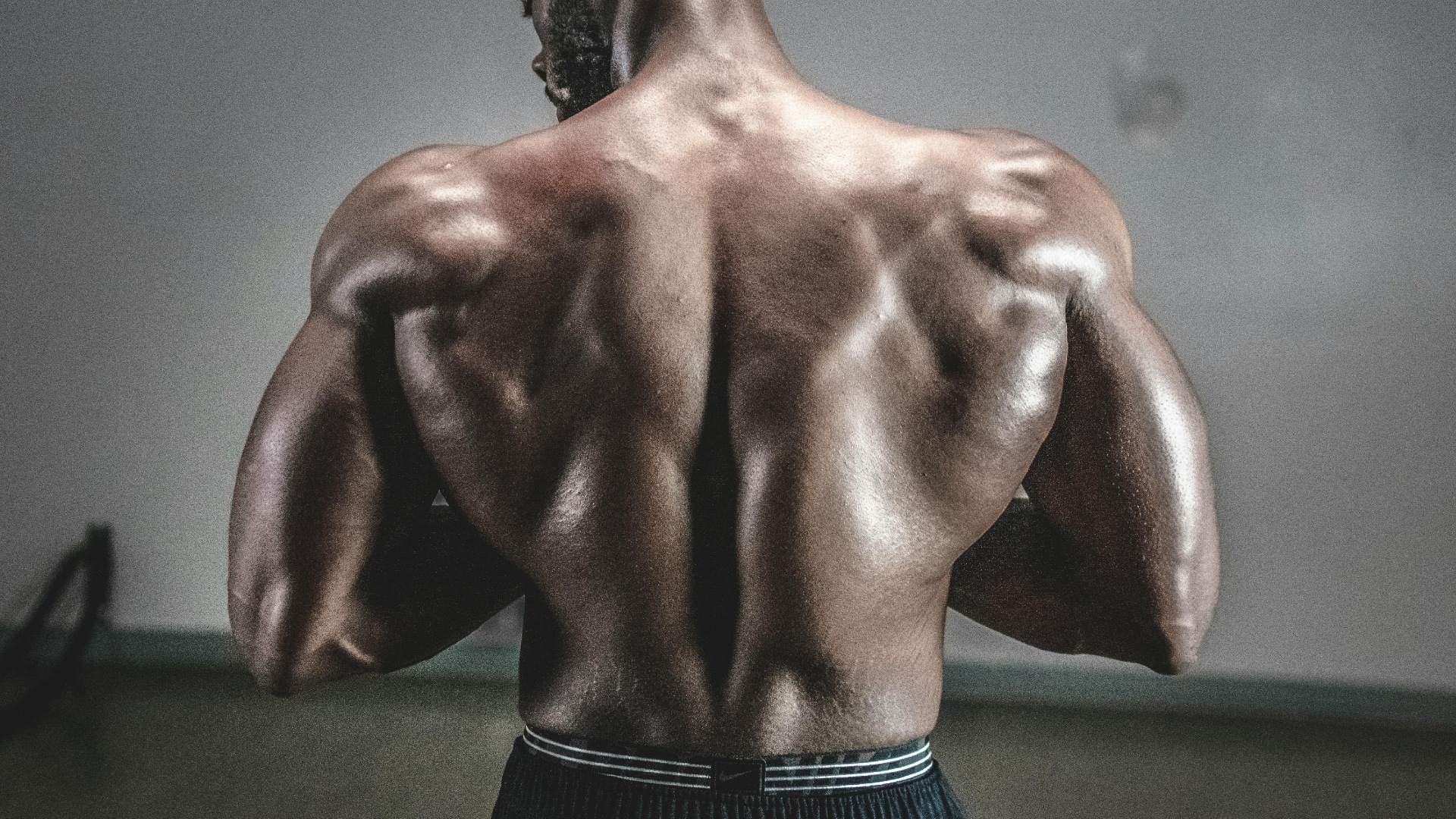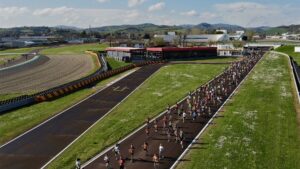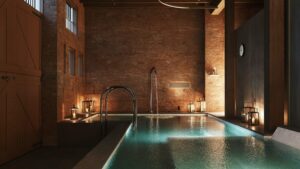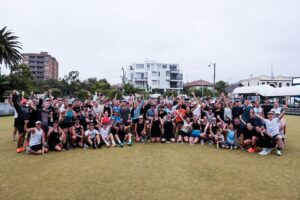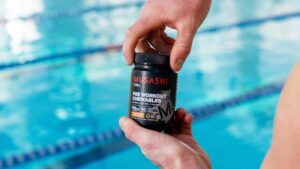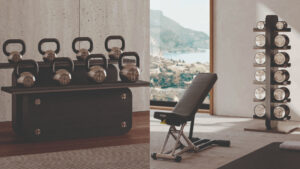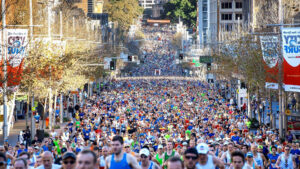Are you looking to strengthen your upper back, forearms, and shoulders? You’ve come to the right place, because the best rear delt exercises are what you need. Bodyweight rear delt exercises play a big part in any fitness routine meant for building muscle (1). Shoulder workouts will strengthen your upper body muscles and prevent injuries when training at the gym.
So what are the best shoulder exercises specific to your delts? In the guide below, we will teach you about the best workouts to strengthen your back, grow your muscles, and keep your core stable (2).
You will also learn about the benefits of rear delt exercises, such as greater strength overall and better health on a day-to-day basis. Below, we will outline key information about the deltoid muscle and its anatomy. Lastly, we answer the most common questions about rear delt exercises.
Jump To:
- Understanding The Deltoid Muscle Anatomy
- Why It’s Important To Train Your Rear Delts
- How To Get Bigger Rear Delts
- The 21 Best Rear Delt Exercises
- 1. Incline Reverse Dumbbell Fly
- 2. Seated Bent-Over Dumbbell Raise
- 3. Standing Bent-Over Dumbbell Raise
- 4. Lying Rear Delt Circles
- 5. Barbell Face Pull
- 6. Snatch Grip Push Press
- 7. Standing Rope Face Pull
- 8. Bent-Over Rear Delt Cable Raise
- 9. Inverted Row Exercise
- 10. Resistance Band Reverse Fly
- 11. Resistance Band Face Pull
- 12. Single-Arm Bent-Over Row
- 13. Standing Bent-Over Lateral Raise
- 14. Cable Machine High Pull Using Ropes
- 15. Assisted Pullups
- 16. External Rotation On the Side
- 17. Workout On the Rear Deltoid Machine
- 18. Standard Pushups
- 19. Incline Bench Press
- 20. Overhead Press With Dumbbells
- 21. Straight Arm Circles
- Final Thoughts
- The Boss Hunting Fitness Reviewer — Jono Castano, Certificate IV in Fitness, Precision Nutrition Level 1
Below, we describe the 21 best rear delt exercises and tricep workouts to boost your overall health and strengthen your muscles.
Editor’s Note: The fitness content on Boss Hunting is informative in nature, but it should not be taken as medical or professional fitness advice. When starting a new training regimen and/or diet, consulting with a trusted medical professional or trainer is always a good idea.
Understanding The Deltoid Muscle Anatomy
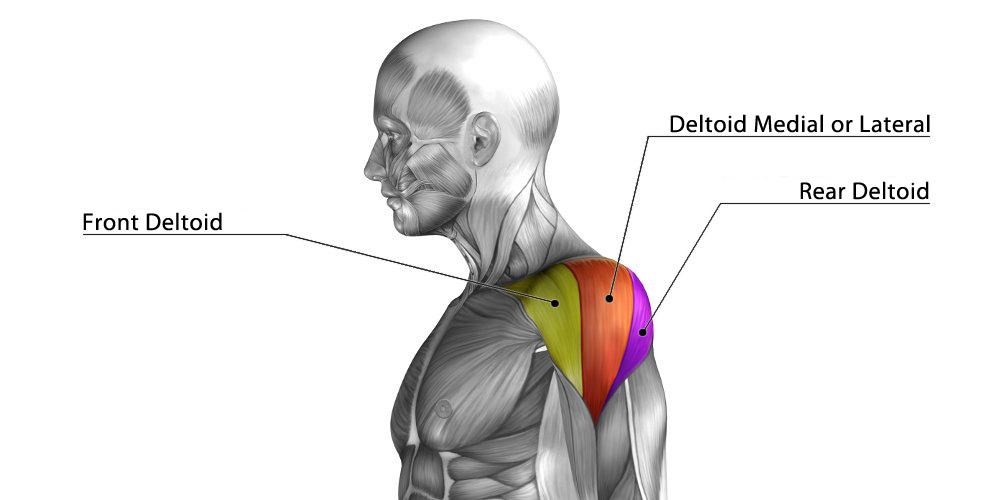
The deltoid muscle is the main one comprising the shoulder. It stretches to connect with the upper back muscles, like the trapezius muscle. It starts at the shoulder blade and moves toward the collarbone. The deltoid has three parts that make up the entire shoulder muscles, which include:
- The lateral deltoid
- The posterior deltoid
- The anterior deltoid
The three parts are essential for the mobility of your upper arm and shoulder. The lateral deltoid is needed to rotate the shoulder joint to the side and away from the rest of the body. It is also responsible for moving the shoulder joint downward.
The posterior deltoid muscles help move the arm outward and backward. Essentially, posterior deltoids help you move your arm toward your back or spine. It can help with motions like getting dressed or throwing an object.
The anterior deltoids are on the front of your shoulder, helping you move your arm forward in any reaching motion you perform. It connects to your collarbone and is the deltoid muscle you use most in everyday life.
Why It’s Important To Train Your Rear Delts
Your rear delts are a very important muscle when it comes to the overall appearance of your upper body, your posture, and the stability of your shoulder. With a strong set of rear delts, you’ll be able to perform pulling exercises more effectively, such as seated rows, pull-ups, and shoulder presses, have a more upright and confident posture, as well as reduce the risk of shoulder injury that might occur.
How To Get Bigger Rear Delts
When it comes to developing a strong pair of rear delts, ensure you aren’t lifting too much weight and you’re able to isolate the muscles at the rear of your shoulder. Stretching the muscle out while contracting it is also important for growth and strength, so lift a lighter weight and make sure you can feel the muscles in the back of your shoulder working throughout.
The 21 Best Rear Delt Exercises
1. Incline Reverse Dumbbell Fly

- Difficulty: Beginner
- Target muscles: Rhomboid muscles and rear deltoid muscles
- Equipment needed: Dumbbells, incline bench
- Sets: 3-4
- Reps: 8-12
- Rest: 60 seconds
Benefits: The incline reverse dumbbell fly allows you to contract your shoulder and back muscles well. You will only need a bench and some dumbbells to perform this exercise. It’s a simple yet, important workout. It will strengthen your shoulder or rear delt muscles. This exercise is perfect for beginners, and you can complete about ten repetitions or as many as you prefer. Listen to your body to avoid pulling any muscles.
Follow these steps:
- Lie down on a bench at a 45-degree incline with your stomach touching the bench.
- Hold dumbbells in both hands.
- Raise both dumbbells at shoulder level to the sides at the same time.
- Hold them in place for a second.
- Lower the dumbbells and repeat.
2. Seated Bent-Over Dumbbell Raise
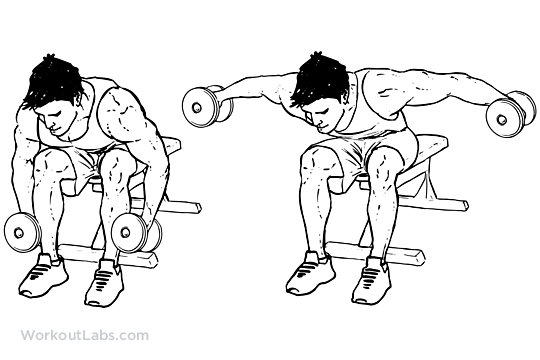
- Difficulty: Beginner
- Target muscles: Rhomboid muscles, trapezius muscle, and triceps
- Equipment needed: Dumbbells, bench
- Sets: 2-4
- Reps: 10-15
- Rest: 60 seconds
Benefits: The seated bent-over dumbbell raise works great at getting those rear deltoids stronger and injury-proof. Out of all the dumbbell rear delt exercises, this workout makes one of the biggest impacts on improving your upper body strength. Make sure to use low-weight dumbbells, especially if you are a beginner. Lighter weights allow you to elongate your motion into a reverse fly.
Follow these steps:
- Sit down on a flat bench with your feet shoulder-width apart.
- Bend your upper body forward at a 60-degree angle while holding a dumbbell in each hand down at your feet.
- Bring your arms out to the sides and hold them for one second.
- Lower your arms and repeat.
3. Standing Bent-Over Dumbbell Raise
- Difficulty: Beginner
- Target muscles: Rhomboid muscles, lower back muscles, trapezius muscle, and triceps
- Equipment needed: Dumbbells
- Sets: 3-4
- Reps: 6-10
- Rest: 60 seconds
Benefits: Rear deltoid exercises like the standing bent-over dumbbell raise only require dumbbells and your own strength. Do you want the best shoulder training and ab workout with this rear deltoid exercise? It works best when you go slowly. Bring the dumbbells up with your feet shoulder width and then slowly lower them down.
Follow these steps:
- Bend at the waist while holding a dumbbell in each hand.
- Stand with your feet hip-width apart.
- Lift the dumbbells at shoulder level to the sides.
- Lower the dumbbells back to the starting position and repeat.
4. Lying Rear Delt Circles
- Difficulty: Beginner
- Target muscles: Deltoid muscles and trapezius muscle
- Equipment needed: Dumbbells, bench
- Sets: 3-4
- Reps: 8-12
- Rest: 60 seconds
Benefits: For the lying rear delt circles, you’ll need to get a flat bench and a couple of dumbbells. Your whole body will get a nice workout with this example of the best rear delt exercises. Essentially, you will lie down in a Superman position and strengthen your core.
Follow these steps:
- Lie down on your stomach on a flat bench.
- Hold a Superman position and bring two dumbbells in front of your head in each hand.
- Bring the dumbbells to the side into a circular position until your hands reach your hips.
- Now, move the dumbbells back to the starting position and repeat the process.
5. Barbell Face Pull
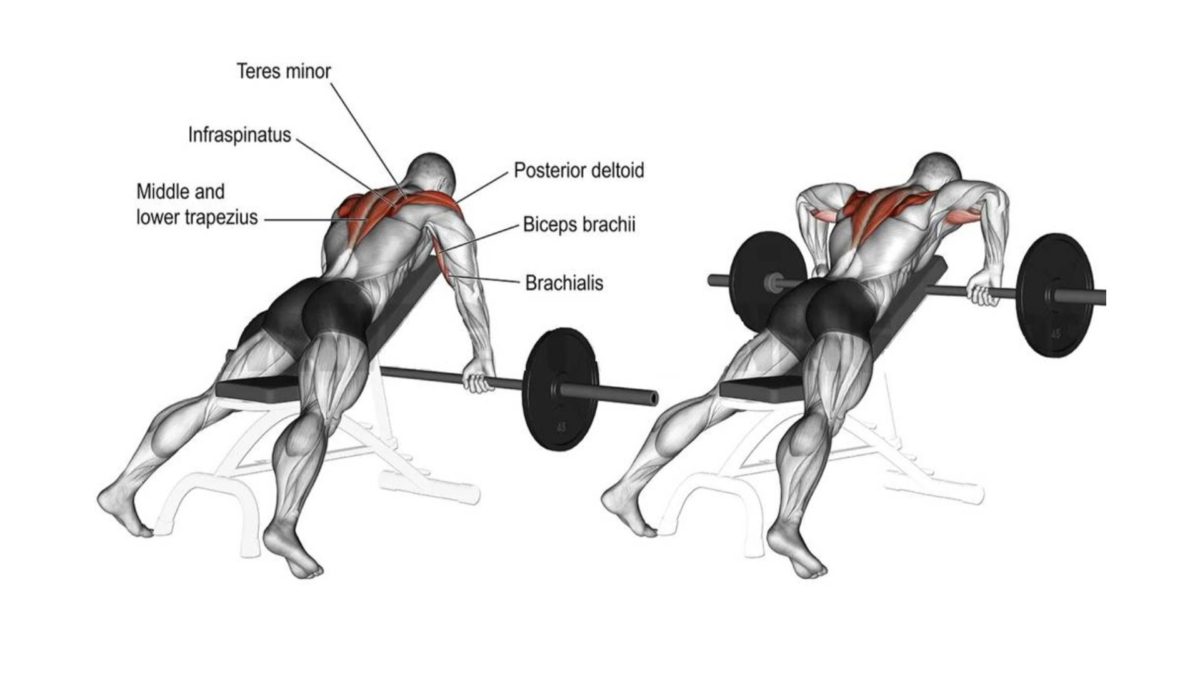
- Difficulty: Beginner
- Target muscles: Rhomboid muscles, trapezius muscle, and biceps
- Equipment needed: Barbell, incline bench
- Sets: 3-4
- Reps: 8-10
- Rest: 60 seconds
Benefits: Pulling movements are essential for the rear deltoid workout, known as the barbell face pull. Keep your elbows wide to get the muscles working as the exercise intends. You can use a cable machine or a barbell for the exercise. You will also need a bench at an incline to perform the workout.
Follow these steps:
- Lie down on your stomach on the inclined bench while holding a barbell underneath in both hands.
- Keep your elbows wide and pull the barbell up to your eye level.
- Make sure to contract your shoulder blades together.
- Lower the barbell back to the starting position and repeat.
6. Snatch Grip Push Press
- Difficulty: Beginner
- Target muscles: Front delts, trapezius, quadriceps, glutes, and core
- Equipment needed: Barbell
- Sets: 3-4
- Reps: 8-10
- Rest: 60 seconds
Benefits: The snatch grip push press is a more complex exercise. We recommend it for those with a moderate amount of experience. Are you a beginner? Then you may want to avoid the snatch grip push press. Nonetheless, the exercise will surely boost your muscle mass in the rear deltoids. Since it’s a more challenging exercise, start with a lower weight and learn the position of the workout. You will need only a barbell for the rear deltoid workout.
Follow these steps:
- Hold the barbell behind your head on your shoulders and grip it with both hands.
- You need to have a slight bend in your knees and then straighten them out.
- Immediately, raise the barbell over your head.
- Lower the barbell while bending your knees at the same time.
- Repeat for as many repetitions as you prefer.
7. Standing Rope Face Pull
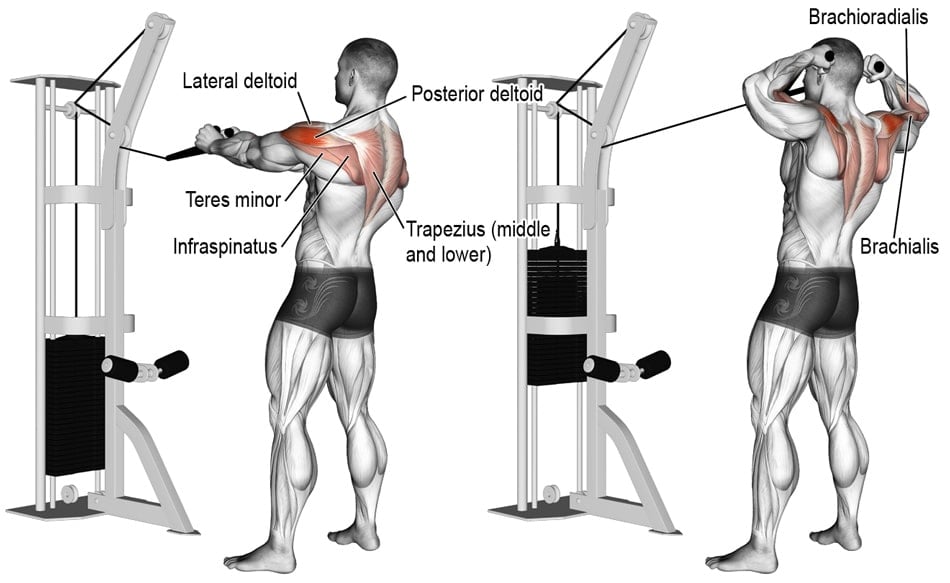
- Difficulty: Beginner
- Target muscles: Posterior and lateral delts, trapezius and rotator cuff muscles
- Equipment needed: Cable machine
- Sets: 3-4
- Reps: 8-12
- Rest: 60 seconds
Benefits: You will need a cable machine to perform the standing rope face pull exercise. The pulley system needs to stay at chest height or lower to get the right strength training for your deltoid muscles. Otherwise, you won’t perform the workout correctly if it’s set up too high.
Follow these steps:
- Grip the rope with both hands and take a few steps backwards.
- Drop your shoulders and keep your feet shoulder-width apart with a slight bend.
- Pull the rope toward your face with the elbows slightly higher than your wrists until your shoulder blades touch.
- Move the rope back to the starting position.
8. Bent-Over Rear Delt Cable Raise
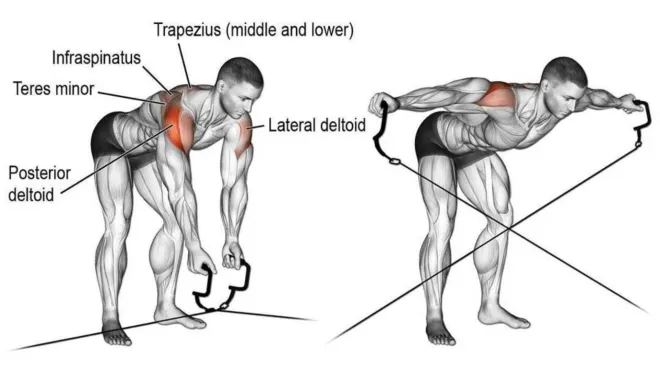
- Difficulty: Beginner
- Target muscles: Posterior and lateral delts, trapezius
- Equipment needed: Cable machine
- Sets: 3-4
- Reps: 5-10
- Rest: 60 seconds
Benefits: You will need a cable machine for the bent-over rear delt cable raise exercise. The workout strengthens your shoulder muscles, as your shoulders are the main part moving during the exercise. The effective cable rear delt exercises can help you fix muscle imbalances over time.
Follow these steps:
- Hold the left cable pull with your right hand, and hold the right cable using your left hand.
- Bend your back at a 90-degree level to your legs and keep your feet hip-width apart.
- Pull the cables and raise your arms to the sides until they reach shoulder level.
- Move your arms back to the starting position and repeat.
9. Inverted Row Exercise
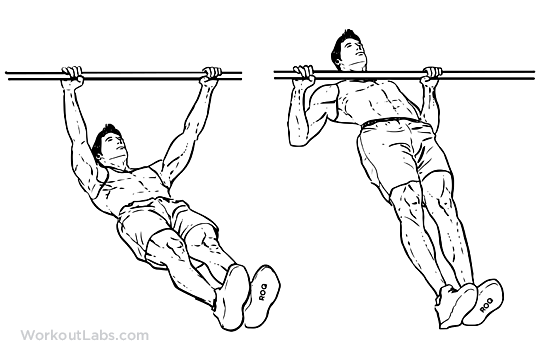
- Difficulty: Beginner
- Target muscles: Trapezius, lattissimus dorsi, biceps, and posterior deltoids
- Equipment needed: Hip-height bar
- Sets: 3-4
- Reps: 5-10
- Rest: 60 seconds
Benefits: You will need to use a Smith machine for the inverted row exercise. The rear delt row workout forces you to pull up your entire body using your triceps, upper back, and shoulder muscles. That way, you will quickly build up strength and grow your muscle mass.
Follow these steps:
- Put your legs and body in a straight line underneath a barbell while holding onto the barbell with both hands.
- Keep your arms straight out.
- Pull up your body using your shoulder muscles with your elbows outstretched.
- Keep your body straight to strengthen your core.
- Move back to the starting position and repeat.
10. Resistance Band Reverse Fly
- Difficulty: Beginner
- Target muscles: Rhomboid muscles, posterior deltoids
- Equipment needed: Resistance band
- Sets: 3-4
- Reps: 8-12
- Rest: 60 seconds
Benefits: Resistance bands are great ways to work your muscles, including the rear delt muscle. To get the rear delts properly exercised, try a strong resistance band and keep your arms extended straight when pulling. The resistance band reverse fly workout will strengthen your shoulder joints.
Follow these steps:
- Put the resistance band around a pole and hold the band in both hands.
- Move back a few steps until the resistance band is taut.
- Bring your arms up to shoulder level and pull at the band with both hands simultaneously.
- Pull the bands to the side until your shoulder blades touch.
- Bring your arms back together to the centre and repeat.
11. Resistance Band Face Pull
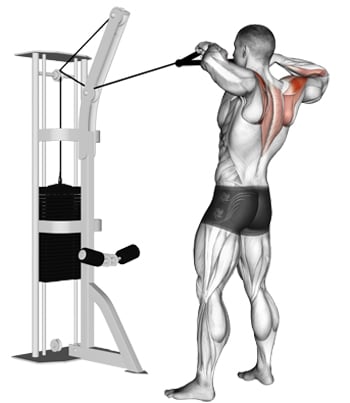
- Difficulty: Beginner
- Target muscles: Rear delts, trapezius, and rhomboids
- Equipment needed: Resistance band or cable machine (pictured)
- Sets: 3-4
- Reps: 8-12
- Rest: 60 seconds
Benefits: You can focus on rear delt development right at home using a resistance band face pull exercise. Similar to a cable pulley, the resistance band can help you grow your muscles. You will also need to use a pole or a bedpost to wrap the band around.
Follow these steps:
- Wrap the resistance band around a pole.
- Hold the band in both hands and take a few steps back.
- Keep your arms at shoulder level and pull the band back toward your face.
- Bring the resistance band back to the original position and repeat.
12. Single-Arm Bent-Over Row
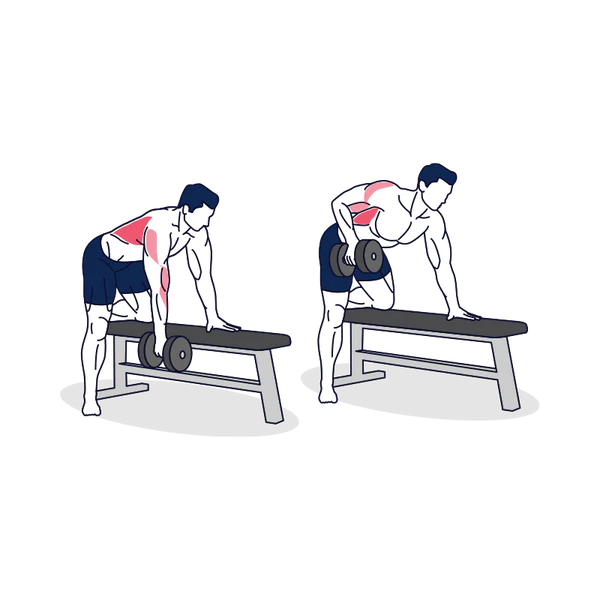
- Difficulty: Beginner
- Target muscles: Rear deltoids, transverse abdominals, triceps, biceps
- Equipment needed: Dumbbell, bench
- Sets: 3-4
- Reps: 8-12
- Rest: 60 seconds
Benefits: The single-arm bent-over row exercise is an excellent way to strengthen your posterior deltoids. It’s great for improving your mobility in the shoulder joints. You will need merely two dumbbells and a bench to complete the exercise.
Follow these steps:
- Position your left knee and left hand on the bench while keeping your elbow straight.
- Keep your other foot on the floor and straighten your back.
- Hold a dumbbell in your right hand while your arm falls to the floor.
- Bend your right elbow and pull up until your shoulder blades squeeze together.
- Slowly reverse the movement and bring the dumbbell down toward the floor.
- Repeat the steps.
13. Standing Bent-Over Lateral Raise
- Difficulty: Intermediate
- Target muscles: Hamstrings, triceps, rhomboid muscles, and trapezius muscle
- Equipment needed: Barbells
- Sets: 3-4
- Reps: 8-12
- Rest: 60 seconds
Benefits: The standing bent-over lateral raise is not an easy exercise for beginners, so make sure to start with lightweight dumbbells. Once your deltoids get stronger and your shoulder muscles grow, you can start to increase the weight of your dumbbells. That way, you will not risk injury as a beginner.
Follow these steps:
- Hold a dumbbell in each hand with the palms facing each other.
- Stand with your feet hip-width apart, with your upper body bent at the hips and a slight bend in your knees.
- Raise your arms out to the side until you reach shoulder level.
- Squeeze your shoulder blades at the end of the movement.
- Slowly, move the dumbbells back to the starting position.
- Repeat the movements.
14. Cable Machine High Pull Using Ropes
- Difficulty: Beginner
- Target muscles: Rear deltoid muscles, lateral deltoids, rhomboids, and trapezius
- Equipment needed: Cable machine
- Sets: 3-4
- Reps: 8-12
- Rest: 60 seconds
Benefits: Training routines for your shoulder muscles should include the cable machine high pull with ropes. It’s a superior way to change things up when working out your shoulders and back. You will need a cable machine that has a rope attached with two handles. The exercise provides a different angle at which your deltoids get exercised, which can further strengthen those muscles.
Follow these steps:
- Keep your feet hip-width apart and your body facing the equipment.
- Put the cable attachment to your chest and attach the rope handle.
- Take a few steps back and stretch out your arms.
- Pull the ropes toward your body and keep your elbows high to strengthen the deltoid muscles.
- Have your elbows slightly bent back to the starting position slowly and deliberately. Repeat the steps.
15. Assisted Pullups
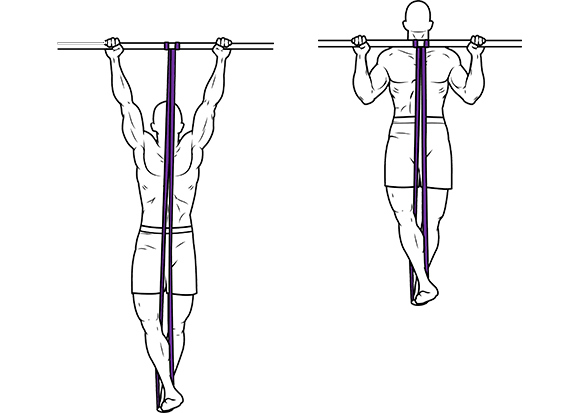
- Difficulty: Beginner
- Target muscles: Deltoid muscles, trapezius muscle, biceps, latissimus dorsi
- Equipment needed: Overhead bar, resistance band
- Sets: 3-4
- Reps: 6-8
- Rest: 60 seconds
Benefits: Pullups are an excellent motion for strengthening your upper back and shoulders. They make for an effective exercise, but you may not have the strength to pull yourself up at the beginning. Most beginners don’t have that type of strength. As such, you may want to perform assisted pullups as a beginner using an assisted pullup machine. You will get stronger deltoids, trapezius muscle, and biceps with the workout.
Follow these steps:
- Pick the weight that you prefer on the machine.
- Put your knees on the knee pad and change the height to fit your body.
- Grab the handles above you and extend your arms.
- Lower your body to the beginning position.
- Pull your body up to the same level as the handles.
- Hold the position for a couple of seconds and drop down slowly.
- Repeat the steps.
16. External Rotation On the Side
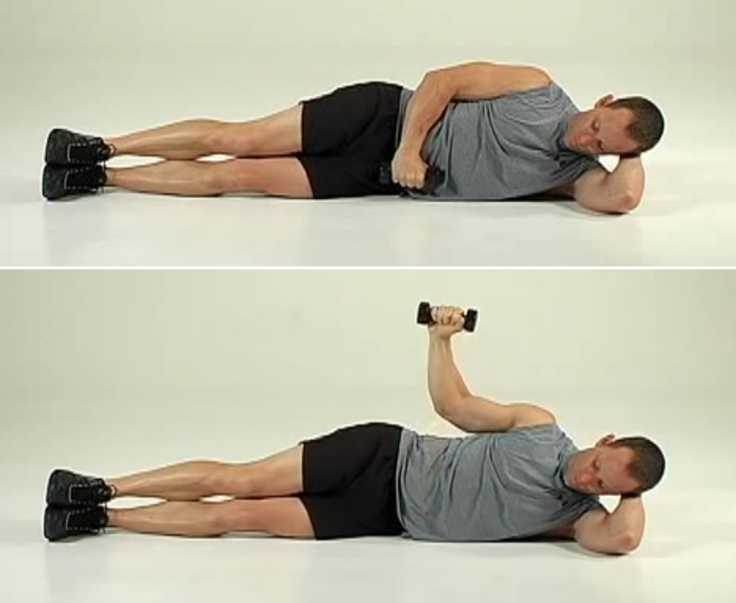
- Difficulty: Beginner
- Target muscles: Rear deltoids, rhomboids, trapezius muscle, and rotator cuff muscle
- Equipment needed: Dumbbell
- Sets: 3-4
- Reps: 8-10
- Rest: 60 seconds
Benefits: The workout here focuses on an external rotation movement. The motion will make your posterior deltoids get a good workout. You will also hit those rotator cuff muscles to strengthen them well. You will need a dumbbell to perform the exercise, along with a towel.
Follow these steps:
- Lie down on your side with a lightweight dumbbell in your hand.
- Bend your elbow to 90 degrees with the upper arm on the side. Put a rolled towel between your arm and torso.
- Rotate your arm upward and hold for several seconds.
- Slowly lower your arm back down to the starting position and repeat.
17. Workout On the Rear Deltoid Machine
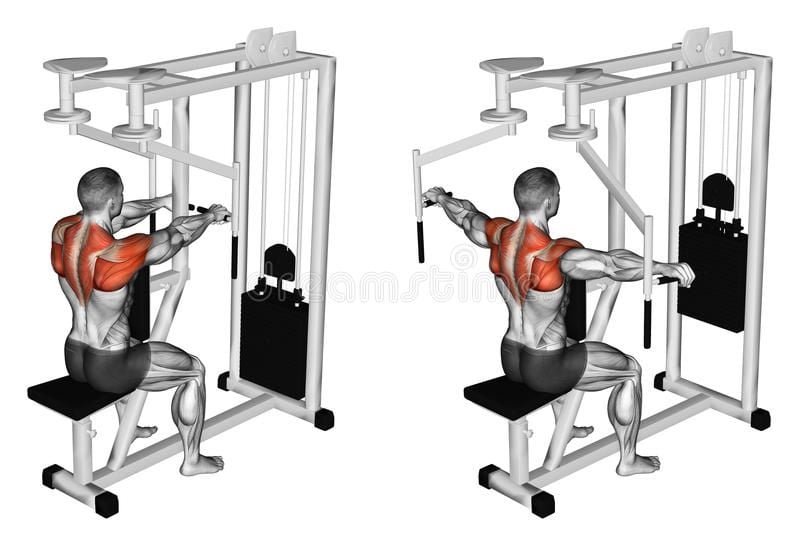
- Difficulty: Intermediate
- Target muscles: Rear deltoids, rhomboids, and middle trapezius muscle
- Equipment needed: Rear delt machine
- Sets: 3-4
- Reps: 10-12
- Rest: 60 seconds
Benefits: Great for your posterior deltoid muscles, you’ll need a rear deltoid machine that will help strengthen those shoulder muscles. The equipment works to target those specific muscles. It won’t be easy on your back, but the machine will keep you safe and injury-free.
Follow these steps:
- Sit down on the rear deltoid machine and face the pad. Adjust the height of the seat to keep the handles level with your shoulders.
- Hold the handles with palms facing down and move your arms backwards.
- Make sure your shoulder blades touch.
- Hold for a few seconds and bring the movement back to the starting position.
- Repeat the movement.
18. Standard Pushups
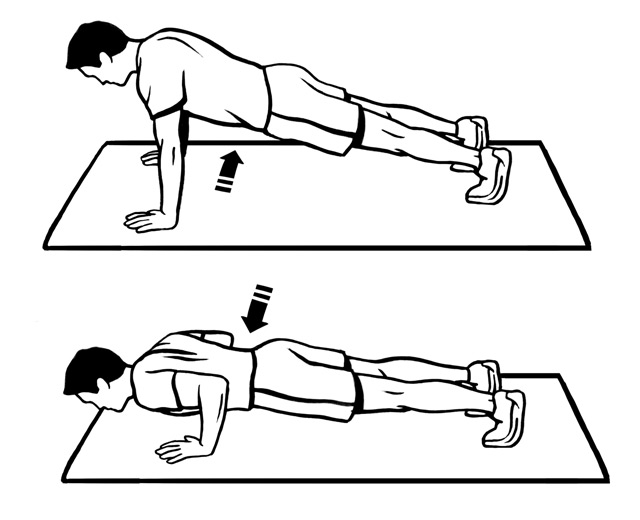
- Difficulty: Beginner
- Target muscles: Deltoid muscle group, triceps, and pectoral muscles.
- Equipment needed: None
- Sets: 3-4
- Reps: 10-15
- Rest: 60 seconds
Benefits: Pushups provide a major way to get your shoulders stronger in a simple exercise that you can do anywhere. You can build muscle mass and strengthen your upper back with a good number of pushups. Some even claim that the standard pushup is the best way to boost your rear delt muscle growth. You can do the exercise without needing an ounce of equipment.
Follow these steps:
- Get on the floor with your stomach facing the ground. Put your legs behind you.
- Put your feet about hip-width apart.
- Lower your upper body closer to the floor. Hold the position for several seconds.
- Push yourself up and keep your body parallel to the floor to strengthen your core.
- Repeat the first four steps.
19. Incline Bench Press
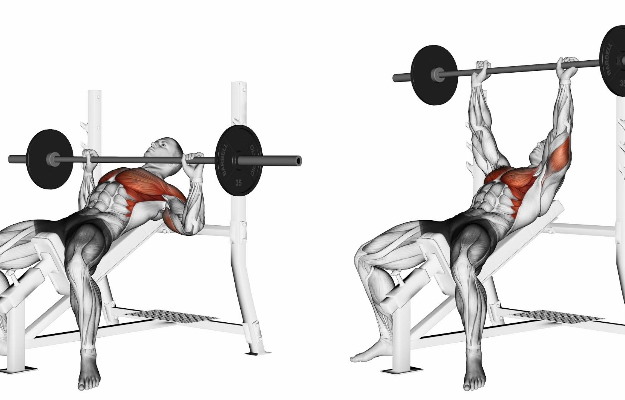
- Difficulty: Intermediate
- Target muscles: Deltoid muscle group, pectorals, and trapezius
- Equipment needed: Incline bench rack and barbell
- Sets: 3-4
- Reps: 8-12
- Rest: 60 seconds
Benefits: As an effective way to keep your shoulders strong, the incline bench press can improve your deltoid muscle growth. It can even strengthen your pectoral muscles. The best part? It’s an easy exercise to perform. You will need a bench and a dumbbell or a barbell.
Follow these steps:
- Get the bench to a 45-degree incline.
- Get a good grip on your barbell or dumbbell.
- Bend your arms to the side and lift the weights upward above your chest.
- Stretch your arms out fully in front of your chest.
- Bring the weights back to the first position and repeat the steps.
20. Overhead Press With Dumbbells
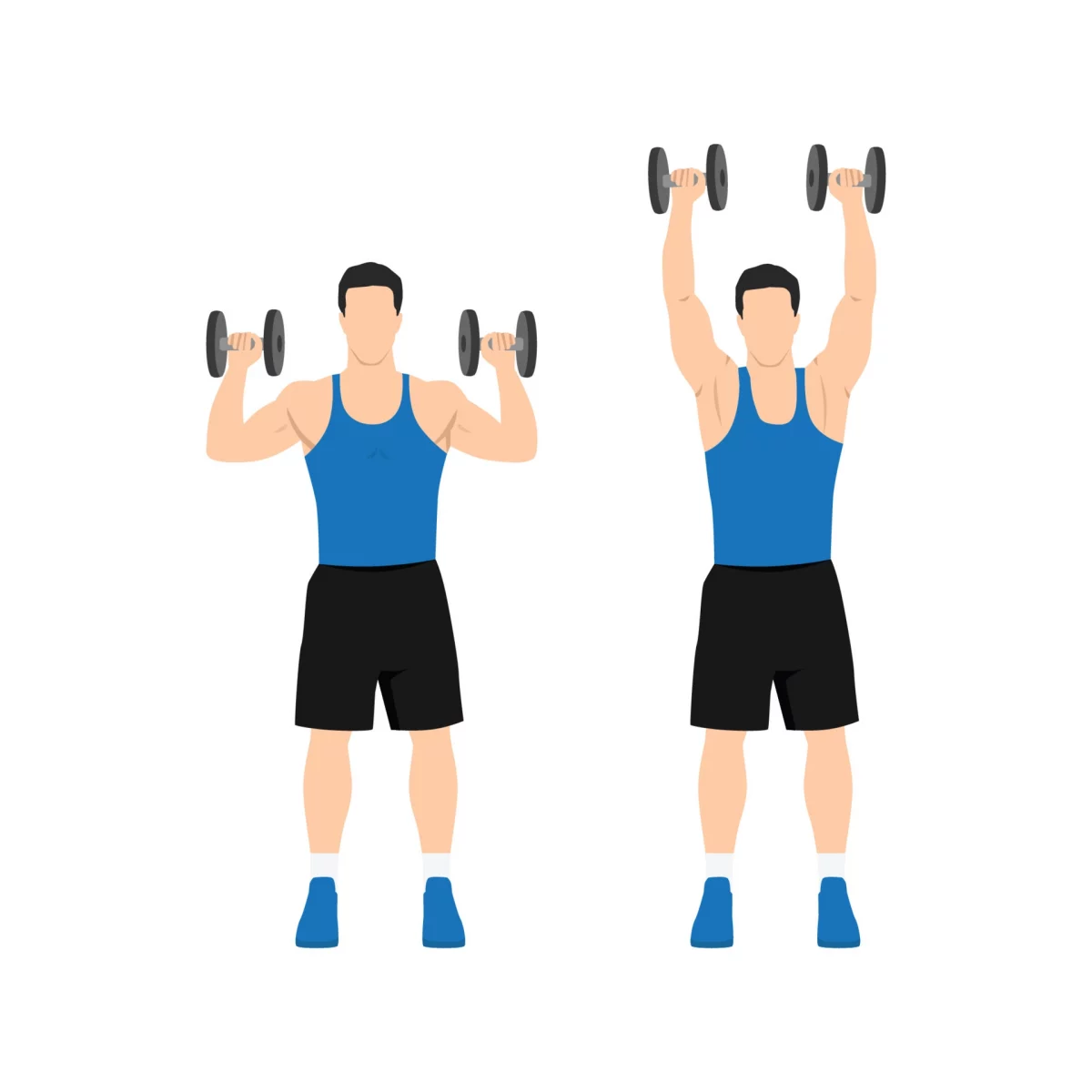
- Difficulty: Beginner
- Target muscles: Deltoid muscle group, trapezius muscle, triceps, and pectorals
Reps: 8-12 per set - Equipment needed: None
- Sets: 3-4
- Reps: 8-12
- Rest: 60 seconds
Benefits: To create strength and grow your shoulder muscles, the overhead press with dumbbells is a great exercise to try. You can use lightweight dumbbells if you’re a beginner and heavier weights as you gain more strength.
Follow these steps:
- Stand straight and keep your feet hip-width apart.
- Lift the dumbbells to the level of your shoulders.
- Lift the dumbbells over your head. Keep it there for a couple of seconds.
- Lower it back down slowly. Repeat the steps.
21. Straight Arm Circles
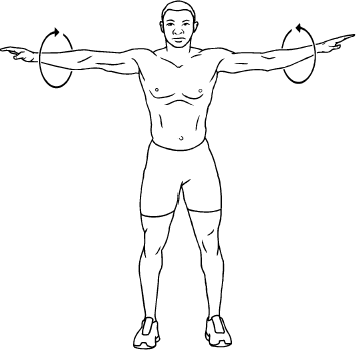
- Difficulty: Beginner
- Target muscles: Deltoid muscle group, rotator cuffs, trapezius
- Equipment needed: None
- Sets: 3-4
- Reps: 10-15
- Rest: 60 seconds
Benefits: The best forearm exercises include straight arm circles, which work the muscles all across your arms, shoulders, and upper back. It’s a great way to stretch out your muscles and warm up before a workout or cool down at the end. This example of the best rear delt exercises will also improve your mobility.
Follow these steps:
- Stand up straight and stretch your arms out into a T position.
- Make circles with your arms and widen them over time.
- Reverse the direction of your circles after 20 or 30 seconds.
Final Thoughts
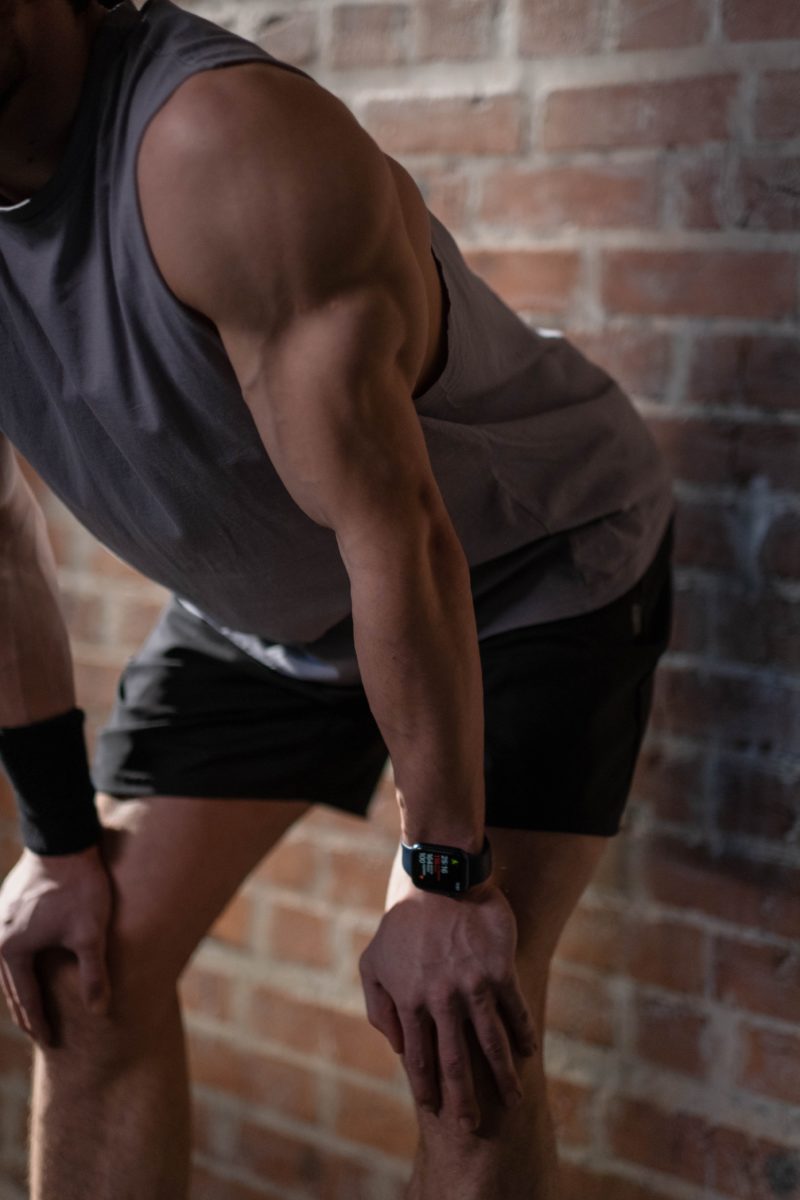
Now that you’ve learned about the best rear delt exercises to boost muscle growth around your shoulders, you can improve your health and ensure to perform the right weight training exercises. You will strengthen your body, prevent injuries, and potentially reduce your risk of osteoporosis.
You may also find it interesting to learn about the top exercises to strengthen your forearms.
Citations
- Rear Deltoid Training Significance, 1UPNutrition, 28 November 2017.
- Optimizing Performance by Improving Core Stability and Core Strength, Sports Medicine, 7 October 2012.
The Boss Hunting Fitness Reviewer — Jono Castano, Certificate IV in Fitness, Precision Nutrition Level 1
Jono Castano is a Sydney-based celebrity personal trainer and certified nutrition coach who specialises in fitness, training, workouts and diet plans. He is the co-founder of the popular Acero fitness brand and fitness app and has become well-known for his extensive work with noted figures like Rebel Wilson, Jessica Mauboy, Lincoln Lewis, Joel Creasy, and The Veronicas.
Jono has built a large social media following with over 800,000 subscribers on Instagram. He has also been profiled by publications such as Men’s Health and has become one of the most recognisable fitness instructors in Australia.
- Location: Sydney, Australia
- Credentials: Certificate IV in Fitness, Precision Nutrition Level 1
- Expertise: Fitness, Training, Personal Training, Workouts, Diet Plan
Editor’s Note: The fitness content on Boss Hunting is informative in nature, but it should not be taken as medical or professional fitness advice. When starting a new training regimen and/or diet, consulting with a trusted medical professional or trainer is always a good idea.
Did you enjoy this article on the best shoulder exercises? Check out a few of Boss Hunting’s other workout guides below:
- The 15 Best Exercises For The Perfect Leg Workout
- The 12 Best Shoulder Exercises For Improved Strength & Size
- The 15 Best Exercises For The Perfect Leg Workout
- The 16 Best Chest Exercises & Workouts For Men
- How To Bench Press [A 101 Guide For The Average Bloke]
- The 9 Best Lat Exercises For Improved Strength & Size
- The 11 Best Tricep Exercises For Improved Strength & Size
- The 15 Best Bicep Exercises & Workouts For Men
- The 15 Best Ab Workouts & Exercises For Summer
- The 16 Best Oblique Exercises & Workouts For Men
- The 13 Best Trap Exercises & Workouts For Men
- The 10 Best Forearm Exercises & Workouts For Men
- 5 First Time Marathon Tips From Olympic Runner Brett Robinson
- The 25 Best Dumbbell Exercises & Workouts You Don’t Need A Gym For
- Why The 75 Hard Challenge Can Work For You
For more information to consider about diet, nutrition and, fitness equipment, check out below:
- Does Intermittent Fasting Actually Work? We Tested It Out
- How To Lose Weight Fast: 10 Simple Tips To Shed Fat More Efficiently
- The 7 Best Massage Guns You Can Buy In Australia
- The 13 Best Exercise Bikes To Stay Fit This Winter
- The 22 Best Mountain Bikes Money Can Buy Right Now
- The 16 Best Electric Bikes In Australia
- 8 Best Tennis Shoes for Men in Australia
For some celebrity inspiration, check out our celebrity workout guides right here:
- Henry Cavill’s Workout Routine Will Unleash Your Inner Superman
- The Workout That’ll Get You ‘Gladiator 2’ Ripped Like Paul Mescal
- The Chris Hemsworth Workout & Diet Plan Is Inhuman
- Jake Gyllenhaal’s Workout & Diet Plan To Get ‘Road House’ Ripped
- How Jeremy Allen White Got Calvin Klein Model-Jacked
- Joe Rogan’s Workout & Diet Plan Isn’t For The Faint-Hearted
- How Hugh Jackman Trained For His MCU Return In ‘Deadpool & Wolverine’
- Daniel Craig’s Military-Inspired Workout For ‘No Time To Die’
- How Michael Jordan’s Personal Trainer Helped Him Achieve GOAT Status
- The Bruce Lee Workout That Made His Rig Famous
- The Rock’s Intense Workout For ‘Hobbs & Shaw’ Will Bring You To Your Knees
For the best places to improve your health and fitness, check out our recommendations here:
